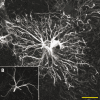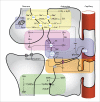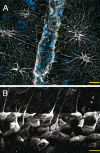The role of astroglia in neuroprotection
- PMID: 19877496
- PMCID: PMC3181926
- DOI: 10.31887/DCNS.2009.11.3/mbelanger
The role of astroglia in neuroprotection
Abstract
Astrocytes are the main neural cell type responsible for the maintenance of brain homeostasis. They form highly organized anatomical domains that are interconnected into extensive networks. These features, along with the expression of a wide array of receptors, transporters, and ion channels, ideally position them to sense and dynamically modulate neuronal activity. Astrocytes cooperate with neurons on several levels, including neurotransmitter trafficking and recycling, ion homeostasis, energy metabolism, and defense against oxidative stress. The critical dependence of neurons upon their constant support confers astrocytes with intrinsic neuroprotective properties which are discussed here. Conversely, pathogenic stimuli may disturb astrocytic function, thus compromising neuronal functionality and viability. Using neuroinflammation, Alzheimer's disease, and hepatic encephalopathy as examples, we discuss how astrocytic defense mechanisms may be overwhelmed in pathological conditions, contributing to disease progression.
Los astrocitos constituyen el principal tipo celular neural responsable del mantenimiento de la homeostasis cerebral. Ellos forman áreas anatómicas altamente organizadas que están interconectadas en extensas redes. Estas caracierísticas, junto con la expresión de una gran variedad de receptores, transportadores y canales iónicos, los favorece de manera ideal para detectar y modular dínámicamente la actívídad neuronal. Los asirocitos cooperan con las neuronas a varios níveles, incluyendo el tránsito y reciclaje de neurotransmisores, la homeostasis iónica, la neuroenergética y la defensa contra el estrés oxidativo. Las neuronas dependen en forma crítica de su soporte constante, lo que le confiere a los astrocitos propiedades neuroprotectoras intrinsecas, las cuales también se discuten aqui. A la inversa, los estímulos patogénicos pueden alterar la función astrocítica, comprometiendo así la funcionalidad y la viabilidad neuronal. Se utilizan como ejemplos la neuroinflamación, la Enfermedad de Alzheimer y la encefalopatía hepática para discutir cómo los mecanismos de defensa de los astrocitos pueden estar sobrepasados en las condiciones patológicas, lo que contribuye a la progresión hacia la enfermedad.
Les astrocytes sont le principal type de cellules neuronales responsables de l'entretien de l'homéostasie cérébrale. Ils s'interconnectent en réseaux étendus, formant des régions anatomiques très organisées. Cette organisation qui s'accompagne de toute une série de récepteurs, transporteurs et canaux ioniques, les met en position idéale pour pressentir et moduler de façon dynamique l'activité neuronale. Les astrocytes coopèrent avec les neurones à différents niveaux, dont le recyclage et la circulation des neurotransmetteurs, l'homéostasie ionique, la neuroénergétique et la défense contre le stress oxydant. Les neurones sont très dépendants du soutien constant des astrocytes, ce qui donne à ces derniers des propriétés neuroprotectrices que nous analysons dans cet article. À l'opposé, lorsque des stimuli pathogènes troublent la fonction astrocytaire, la fonctionnalité et la viabilité des neurones sont compromises. En prenant pour exemples la neuro-inflammation, la maladie d'Alzheimer et l'encéphalopathie hépatique, nous montrerons comment les mécanismes de défense astrocytaires peuvent être débordés en situation pathologique, participant ainsi à la progression de la maladie.
Figures



References
-
- Nedergaard M., Ransom B., Goldman SA. New roles for astrocytes: redefining the functional architecture of the brain. Trends Neurosci. 2003;26:523–530. - PubMed
-
- Rouach N., Koulakoff A., Giaume C. Neurons set the tone of gap junctional communication in astrocytic networks. Neurochem int. 2004;45:265–272. - PubMed
-
- Gadea A., Lopez-Colome AM. Glial transporters for glutamate, glycine, and GABA III. Glycine transporters. J Neurosci Res. 2001;64:218–222. - PubMed
Publication types
MeSH terms
Substances
LinkOut - more resources
Full Text Sources
Medical
